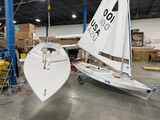2025 Spring Gear Guide
As spring sailing ramps up, it’s time to go through your gear and make sure you’re ready for anything when you go sailing! Whether you’re hitting the water with high school and college sailing or as part of your local Frostbiting fleet, having the right gear is the best way to stay safe. If you’re not comfortable and safe, you’re not going to have any fun! For those high school and college sailors, there is a link at the bottom of this article with a discount code for free shipping and 15% off through March 31st.
Gloves
-
If you’re looking for a the best ‘traditional’ sailing glove, made with 2 or 5 of the fingers cut off for untying knots, we recommend the Rooster Pro Race gloves (Two-finger or five-finger). To get the same manueverability but with slight waterproofing, Rooster’s AquaPro Gloves are a great middle-ground.
-
For those that don’t want their hands to get cold at all, the lobster-fishing-style rubber insulated gloves are the way to go. We recommend this great option from Atlas.
Drysuit
-
The classic, dependable GILL PRO DRYSUIT! Your drysuit is your first and last line of defense against the cold water, and is an essential piece of gear for spring sailing. This will go over a combination of base layers and a sweater or two (no cotton!) to keep you warm and comfortable.
Base Layers
-
Regardless of whether you’re wearing a wetsuit or drysuit, base layers are critical. Not only will the right ones provide the most warmth, but the wrong base layers capture sweat that turns into cold, wet fabric that makes it that much easier to call it a day early.
-
A “hydrophobic” fabric helps address this by wicking sweat away from the body (and water, when layered under a wetsuit). Hydrophobic bottoms are great leggings for inside a drysuit or wetsuit, and I frequently pair a hydrophobic top with something like a Patagonia quarter-zip inside of my drysuit.
Wetsuit
-
As the water gets warmer, folks will start transitioning to wearing wetsuits instead of drysuits. They’re less bulky, but provide less protection. Crucially, a wetsuit works best when actually wet by trapping a tiny layer of water between the neoprene and your skin; this thin layer gets heated up by your body, and prevents the cold from seeping in.The colder the ambient water temperature, the thicker wetsuit needed.
-
We prefer the Zhik Microfleece wetsuit, which combines traditional 1mm neoprene with a thin layer of microfleece to increase warmth. You can also get separate tops and bottoms; I prefer the skiff suit over the pants because it keeps the core just a bit more warm, and won’t fall down after a bad You can layer wetsuit pieces with base layers and finish with a Rooster Pro Lite Aquafleece Top for protection against wind. You can upgrade slightly to the Rooster Pro Aquafleece Top, which is cut the same as the Pro Lite but has taped seams.
ICSA / ISSA Discount Code!
-
College Sailors: Use Coupon Code ICSA for 15% Off
High School Sailors: Use Coupon Code ISSA for 15% Off
Advice & articles
-
Zim ISCA Lift Test - Hull Construction Improvements
13th May 2025When we were selected to be the ISCA builder, we asked the class for a list of issues that they’ve
-
Zim Sailing ISCA® Available Now
7th May 2025PRESS RELEASE - May 8th, 2025 Bristol, Rhode Island - Zim Sailing is proud to announce that product
-
2025 Spring Gear Guide
30th Jan 2025As spring sailing ramps up, it’s time to go through your gear and make sure you’re ready for anythin
- Read more articles




